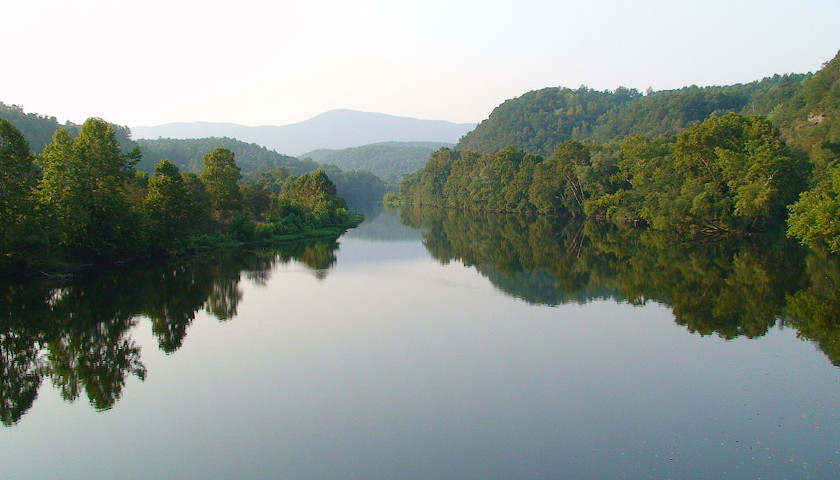The Virginia Department of Health (VDH) is warning people to avoid contact with water in a 12-mile stretch of the James River in Richmond. On Tuesday evening, a Goochland County sewer main ruptured, and remained open for several hours. Three hundred thousand gallons of raw undiluted sewage flowed into Tuckahoe Creek, which flows into the James.
“For the safety of people and pets, VDH is advising that recreational water activities, such as swimming, wading, tubing, and whitewater kayaking (where submersion in the water is likely), should be avoided,” the VDH said in a Thursday press release. “Activities on the waterbodies, which are not likely to result in water submersion (boating, fishing, canoeing), may continue with proper caution to avoid contact with the water.”
VDH’s recreational water advisory includes all of Tuckahoe Creek, and the James River from Robious Landing Park to Belle Isle. VDH Public Information Officer Brookie Crawford said that the Department of Environmental Quality is testing the river, and laboratory results are expected August 3. The VDH plans to update the advisory on August 4.
“Swallowing contaminated water can cause gastrointestinal illnesses, with vomiting, diarrhea, nausea, abdominal pain or fever. Contact with contaminated water also can cause infections of the ears, nose, throat and skin,” Crawford said. “If people believe they were exposed to the water under advisory and are experiencing adverse health effects, they should contact their medical provider and mention their exposure to the recreational water under advisory to facilitate their diagnosis.”
The James River Association (JRA) maintains a map of water safety assessments. Multiple locations in the river near Richmond have red high caution warnings. At the Huguenot Flatwater, downstream of Tuckahoe Creek, on July 29, the report shows an E. Coli concentration of 236 colony forming units (CFU) per 100 milliliters. 2012 EPA recommendations for recreational waters advise a threshold of 126 CFU per 100 milliliters.
JRA Senior Advocacy Manager Jamie Brunkow said, “We’re going to continue to advise people just to be cautious when they’re near the river, and just monitor the health department’s guidance in terms of the advice. I think the most important thing that we want to put out there is just to make sure that people are staying safe.”
City of Richmond Parks, Recreation, and Community Facilities Public Information Manager Tamara Jenkins said that the city is not closing any entry points in the James River Park System. The VDH is posting warning signs at public water access points. The VDH said the Goochland Department of Public Utilities is working to repair the sewer main this week.
Many types of bacteria common in sewage break down in a few days once they’re out of the human gut and in a waterway, according to Persistence of Pathogens in Sewage and Other Water Types from the Global Water Pathogen Project. Still, nutrients, especially nitrogen and phosphorus, can overwhelm waterways, causing algae blooms and harming water life, according to the Chesapeake Bay Program (CBP). The CBP reports that wastewater is a significant source of nutrients in the Bay. The James River flows into the bay.
Lynchburg and Richmond both operate combined sewer overflow systems that can allow sewage to flow into the James River if there is a high amount of stormwater. Lynchburg Department of Water Resources Director Timothy Mitchell told The Star that the city has eliminated over 95 percent of the sewage discharge into the river since the system was built, but there are still some overflows that happen about four times a year.
Richmond Department of Public Works spokesperson Rhonda Johnson said that combined sewer overflows are diluted with rainwater, unlike the Goochland main break. She said her city is also working to eliminate sewer overflows. At the end of June, officials from Richmond, Lynchburg, and Alexandria said in a letter that their cities needed a combined $1.4 billion to complete projects aimed at eliminating combined sewer overflows in their cities.
The Goochland break happened the same day Governor Ralph Northam proposed $411.5 million in American Rescue Plan Act (ARPA) spending aimed at improving drinking water, wastewater, and storm infrastructure. It includes $186.5 million for wastewater treatment and nutrient removal, and $125 million for Richmond, Alexandria, and Lynchburg’s combined sewer overflow projects.
Johnson said Northam’s plan includes $33 million for Richmond.
“The money that Governor Northam has appropriated for us will not cover the entire funding,” Johnson said. “We are seeking additional funding to be able to cover the full amount of a little under $890 million over the next 14 years.”
– – –
Eric Burk is a reporter at The Virginia Star and the Star News Digital Network. Email tips to [email protected].




